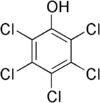Difference between revisions of "Pentachlorophenol"
(New page: === === {{Definition|title=pentachlorophenol (PCP) |definition= Pentachlorophenol is an organochlorine compound used mainly as a fungicide.<ref name = OECD>[http://www.ospar.org/do...) |
Dronkers J (talk | contribs) |
||
| (20 intermediate revisions by one other user not shown) | |||
| Line 1: | Line 1: | ||
| − | + | {{tocright}} | |
{{Definition|title=pentachlorophenol (PCP) | {{Definition|title=pentachlorophenol (PCP) | ||
| − | |definition= Pentachlorophenol | + | |definition= Pentachlorophenol is a white organic solid with needle-like crystals and a phenolic odour<ref name = epa>[http://www.epa.gov/safewater/contaminants/dw_contamfs/pentachl.html www.epa.gov August 6 2009]</ref>. It is an [[organochlorine compounds|organochlorine compound]] used mainly as a fungicide. Sodium pentachlorophenate (NaPCP) and pentachlorophenyl laurate (PCPL), are used for similar purposes<ref name = OECD>[http://www.ospar.org/documents%5Cdbase%5Cpublications%5Cp00138_BD%20on%20pentachlorophenol.pdf OSPAR Commission, 2004: OSPAR background document on pentachlorophenol]</ref>.}} |
| + | |||
| + | == Notes == | ||
| + | |||
| + | {| class="toccolours" border="1" style="float: right; clear: right; margin: 0 0 1em 1em; border-collapse: collapse;" | ||
| + | ! bgcolor="#FF8888" | Pentachlorophenol | ||
| + | |- | ||
| + | | align="center" bgcolor="#FFFFFF" | [[Image:Pentachlorophenol.png|100px|Pentachlorophenol]] | ||
| + | |- | ||
| + | ! bgcolor="#8888FF" | Formula | ||
| + | |- | ||
| + | | align="center" | C<sub>6</sub>HCl<sub>5</sub>O | ||
| + | |- | ||
| + | |} | ||
| + | |||
| + | Production of PCP in the EU ceased in 1992. In 1996, 378 tonnes of NaPCP and 30 tonnes of PCP were imported from the USA, there may possibly be other imports from Asia. NaPCP was mainly used in France, Portugal and Spain, as a control agent to protect newly cut wood surfaces against fungal attacks. Treatment of wood and textiles resulted in release of PCP to the environment. Since 2008 no products which contain more than 0,1% of PCP are allowed to be sold. | ||
| + | |||
| + | Typical concentrations of PCP in the [[North Sea]] are around 0,07 µg/l, with a maximum detected concentration of 0,79 µg/l. These concentrations have been decreasing since 1983<ref name = OECD>[http://www.ospar.org/documents%5Cdbase%5Cpublications%5Cp00138_BD%20on%20pentachlorophenol.pdf OSPAR Commission, 2004: OSPAR background document on pentachlorophenol]</ref>. | ||
| + | |||
| + | Due to it's low water solubility, PCP in the the marine environment will [[adsorption|adsorb]] to sediments, where it is quite stable. In water it can be degraded by photolysis<ref name=epa>[http://www.epa.gov/safewater/contaminants/dw_contamfs/pentachl.html www.epa.gov August 6 2009]</ref>. PCP has a tendency to [[bioaccumulation|bioaccumulate]] and [[biomagnification|biomagnify]] through [[food chain|food chains]]<ref name=epa2>[http://www.epa.gov/safewater/pdfs/factsheets/soc/tech/pentachl.pdf www.epa.gov August 6 2009]</ref>. It also is considered [[toxic]] for marine organisms. In humans it can cause liver damage and have [[endocrine disrupting compounds|endocrine disrupting effects]]<ref>[http://toxipedia.org/wiki/display/toxipedia/Pentachlorophenol www.toxipedia.org August 6 2009]</ref>. | ||
| + | |||
| + | Its main degradation product is [[pentachloroanisole]]. | ||
| + | <P> | ||
| + | <BR> | ||
| + | <P> | ||
| + | |||
| + | == Environmental standards and legislation == | ||
| + | |||
| + | [[OSPAR List of priority substances|Included in the OSPAR list of substances of priority action]] | ||
| + | |||
| + | [[List of priority substances|Included in the water framework list of priority substances]] | ||
| + | <P> | ||
| + | <BR> | ||
| + | <P> | ||
| + | |||
| + | == See also == | ||
| + | |||
| + | [http://www.vliz.be/projects/endis/EDnorth.php?showchemprop=true&showeffects=true&chemeffects=true&chemid=356 Pentachlorophenol on the ED North Database] | ||
| + | |||
| + | [http://www.ospar.org/documents%5Cdbase%5Cpublications%5Cp00138_BD%20on%20pentachlorophenol.pdf OSPAR background document on pentachlorophenol ] | ||
| + | <P> | ||
| + | <BR> | ||
| + | <P> | ||
| + | ==References== | ||
| + | <references/> | ||
| + | |||
| + | {{author | ||
| + | |AuthorID=19826 | ||
| + | |AuthorFullName=Daphnis De Pooter | ||
| + | |AuthorName=Daphnisd}} | ||
| + | |||
| + | [[Category:Toxicity chemicals]] | ||
Latest revision as of 13:33, 9 August 2020
Definition of pentachlorophenol (PCP):
Pentachlorophenol is a white organic solid with needle-like crystals and a phenolic odour[1]. It is an organochlorine compound used mainly as a fungicide. Sodium pentachlorophenate (NaPCP) and pentachlorophenyl laurate (PCPL), are used for similar purposes[2].
This is the common definition for pentachlorophenol (PCP), other definitions can be discussed in the article
|
Notes
| Pentachlorophenol |
|---|

|
| Formula |
| C6HCl5O |
Production of PCP in the EU ceased in 1992. In 1996, 378 tonnes of NaPCP and 30 tonnes of PCP were imported from the USA, there may possibly be other imports from Asia. NaPCP was mainly used in France, Portugal and Spain, as a control agent to protect newly cut wood surfaces against fungal attacks. Treatment of wood and textiles resulted in release of PCP to the environment. Since 2008 no products which contain more than 0,1% of PCP are allowed to be sold.
Typical concentrations of PCP in the North Sea are around 0,07 µg/l, with a maximum detected concentration of 0,79 µg/l. These concentrations have been decreasing since 1983[2].
Due to it's low water solubility, PCP in the the marine environment will adsorb to sediments, where it is quite stable. In water it can be degraded by photolysis[1]. PCP has a tendency to bioaccumulate and biomagnify through food chains[3]. It also is considered toxic for marine organisms. In humans it can cause liver damage and have endocrine disrupting effects[4].
Its main degradation product is pentachloroanisole.
Environmental standards and legislation
Included in the OSPAR list of substances of priority action
Included in the water framework list of priority substances
See also
Pentachlorophenol on the ED North Database
OSPAR background document on pentachlorophenol
References
Please note that others may also have edited the contents of this article.
|